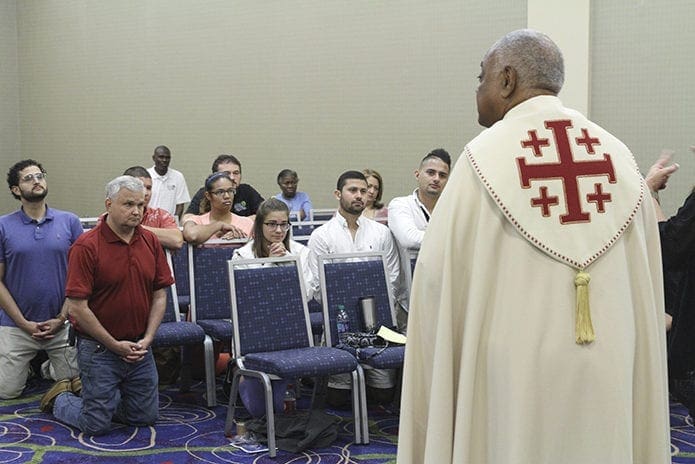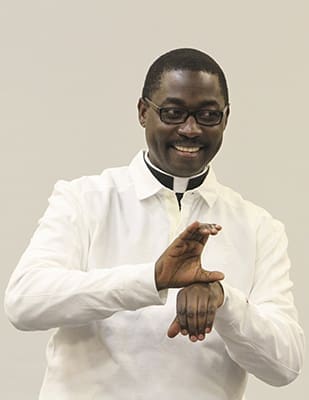 Photo By Michael Alexander
Photo By Michael AlexanderCollege Park
Father Paul Zirimenya invites ASL track to the wedding feast of the Lamb
By KATHY BYRNE, Special to the Bulletin | Published June 23, 2017
COLLEGE PARK—What do the wedding veil, the blood and water flowing from the side of Christ, and the holy Eucharist have in common?
Using humor, personal stories and a colorful PowerPoint, Father Paul Zirimenya creatively answered this and other interesting questions in the American Sign Language track of the Eucharistic Congress. Father Zirimenya expanded the participants’ understanding and recognition of the beauty and strength of the Eucharistic celebration, using these images to bring alive the graces and gifts of the sacrament.
Participants for the ASL track included those who are both deaf and hearing. Since the track was presented in silence using American Sign Language, voice interpreters were present, speaking quietly into microphones connected to assisted listening devices for those who struggle to understand the language. Lisa Palak, Emily Riley and Ashley Walker provided their gifts of voice interpretation for this purpose.
Father Zirimenya, who is deaf, was raised in Uganda, the third of nine children, including two sets of twins. He attended Catholic, Muslim and Baptist schools in Uganda and went to both Masses and Jewish services as a child. He appreciates the fact that “by the time I graduated from college, I was exposed to many different faiths.”
He lost his hearing gradually and was deaf by age 6. He learned sign language when he was 14. Around this same time, a visit from his uncle, a priest, provided the first spark of his calling to the priesthood. A priest in Uganda encouraged and guided him toward his vocation, but through him Father Zirimenya recognized that he would have a difficult time as a deaf priest in Uganda.
He attended school in the United States, earning a master’s degree in divinity from St. Patrick’s Seminary and University in Menlo Park, California. Father Zirimenya said that his father and others were concerned about his ability to make the commitment required for the priesthood. He said, “From age 5, I was taught that when you make a commitment, it is a promise.”
Since becoming a priest, Father Zirimenya has given numerous retreats and workshops for the Catholic deaf community around the country, including a presentation for the International Catholic Deaf Association Conference held at Gallaudet University in Washington, D.C., in 2013.
During the afternoon Archbishop Wilton D. Gregory visited the ASL track, bringing the Blessed Sacrament for adoration. He told Father Zirimenya that he had had the privilege of visiting Uganda twice and personally knew one of the bishops there. The archbishop also expressed his appreciation for the strength of the deaf community, saying, “I thank you for being a sign to us, and for the signs you show us.”
The sign for Eucharist
Prior to beginning his presentation with the Lord’s Prayer, Father Zirimenya mentioned, “I once met a guy who was 14 and didn’t know the Lord’s Prayer. I’ve known it since I was 5.”
He questioned why the word “bread” in the prayer is signed like regular bread purchased at the store.
“We should be using the sign for Eucharist,” he said. He later expanded this idea, stating, “Some say ‘wine’ when it is already the blood of Christ. It is difficult for some to believe this truth,
because it tastes the same.”
He explained that people want proof. “You have to be open, be a light and see the light. We know electricity is here. We can’t see it happening, but we believe it is here because of the lights,” he said.
Father Zirimenya provided the history of the feast of Corpus Christi. St. Juliana, a 13th-century nun in Belgium, had a strong devotion to the Blessed Sacrament and began having visions of the moon in which one part of the moon was always dark. She recognized this signified that the Catholic Church did not have a special liturgy to celebrate the Blessed Sacrament. She took this thought to her confessor, who petitioned the pope about it.

Father Paul Zirimenya, a deaf priest from the Archdiocese of San Francisco, leads the American Sign Language track at this year’s Eucharistic Congress.
The feast of the Body of Christ was thus begun, and was celebrated in early June. In 1849, Pope Pius IX added the feast of the Precious Blood, celebrated in early July. Later the two liturgies were combined to become the solemnity of Corpus Christi, the Most Holy Body and Blood of Christ.
Father Zirimenya said, “It is an expression of our faith in the Real Presence of Christ in the Blessed Sacrament.”
A veil to show holiness
According to the priest, there is great symbolism in opening the wedding veil of a bride, a symbolism shared with the Eucharist.
“The Catholic Church teaches that a man and woman wait and sleep together after marriage,” he signed. “The veil conceals what is sacred because it is most intimate.” He compared this to the veils and coverings of the tabernacle and the veil that covers the chalice in preparation for Mass.
He signed, “With a veil, everything is covered before its use to show its holiness. With Jesus, the church is his bride.”
Other references to the veil by Father Zirimenya included chapel veils, first Communion veils, which are often passed on from grandmother to mother to daughters, and the recognition that a woman must be veiled in order to have an audience with the pope.
Referencing the Catechism of the Catholic Church (No. 1096), which states, “A better knowledge of the Jewish people’s faith and religious life as professed and lived even now can help our better understanding of certain aspects of Christian liturgy,” he provided examples of veils being plentiful and symbolic in the roots of Judaism. His presentation showed examples of Jewish veils: the canopy for the Holy of Holies, the chuppah, or the veiled covering of the Jewish bridal chamber, and the veiled tent for the Old Testament tabernacle, remarkably similar to the one used in the morning procession for the monstrance carried by Archbishop Gregory.
These symbolic coverings showed “God’s covenant with Israel was like a marriage covenant,” he said.
The combination of water and blood
He reminded attendees that, “The Bible begins and ends with a marriage.”
The first is the union of Adam and Eve, where “Eve was created from the side of Adam,” he noted. Father Zirimenya compared this to blood and water flowing from the side of Christ during the crucifixion. “Remember what happened?” he asked. “Jesus said, ‘It is finished,’ and the veil was torn open.” He pointed out that a better translation for Jesus’ words is, “It is consummated. At that point, the church became his bride.”
The last marriage mentioned in the Bible is the wedding feast of the Lamb in Revelation.
Father Zirimenya reminded the group that blood and water are combined during the consecration. He said, “As bridegroom, Christ gives the seed of life to the church as bride, the church receives it, generates new life for his kingdom through the water of baptism and nourishes that new life through the grace of the sacraments—especially the Eucharist (his blood).”
He expounded upon the great love that Jesus has for us in providing us the Eucharist. He discussed the false sense of love the internet has provided. People tend to believe love is shown by the number of likes received on Facebook.
“For most, friendship and love is a difficult concept. But Jesus loves us no matter who we are,” he said. “He never gives up. He keeps coming after you over and over.”
“I must love myself before I can love others,” continued Father Zirimenya. He explained that guilt is “often in the back seat of any situation. People who are grumpy need healing. You need to watch for people’s wounds, and help them heal. Whose faults will you overlook? There are many diverse people in church, but we share the same Eucharist.”
Guilt can be stopped through atonement and the Eucharist, he explained.
“We eat the body of Christ so we may be the body of Christ,” said Father Zirimenya.
We are thus more able to love and give of ourselves, said the priest.
“It is not important how much you give. In Uganda, five dollars feeds a family for one week. What you give matters. The Eucharist assures us we can be part of a thanksgiving miracle,” he said.
To conclude, Father Zirimenya emphasized Jesus’ last will and testament. “When people don’t write a will, it causes confusion in the family,” he said.
He explained that Jesus’ last will and testament was, “Do this in remembrance of me.”
Father Zirimenya said when we follow Jesus’ command, we obey his final wish for us.


